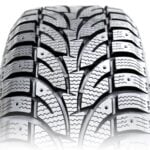First, what exactly is a studdable snow tire & how does it compare to studdless tires?
Studdable snow tires boast conventional winter tire compounds and tread patterns offering excellent traction in snow. Manufacturers mold them specifically to accept optional metal studs, particularly useful for driving in weather where freezing rain, sleet and wet ice are the norm, with ambient temperatures standing nearly at 32° Fahrenheit.
The studdables are mainly a hybrid between studded and studless snow tires. The studded ones come preinstalled with studs, while the studless, as the name implies, have no studs and rely on their tread design and compound to offer traction on snowy and icy roads.
When the conditions are dry, you can remove the studs and still take advantage of excellent winter traction and handling.
When the roads are full of snow and ice during the winter, you can install studs in the tread to enhance the tire’s grip. When the conditions are dry, you can remove the studs and still take advantage of excellent winter traction and handling.
Since some states and provinces do not allow the use of studded tires, affordable studdables like the Sailun IceBlazer WSL1 come as a perfect remedy with their specific tread design and resilient winter rubber compound. This rubber warrants superb handling and traction on various winter surfaces, including snow, ice, and slush.

Pros & Cons of Buying Studdable Winter Tires
Like anything, there are good and bad points going with these types of snow tires. And it depends on a variety of factors including how severe the icy roads conditions are, whether studded tires are even legal in your area, and more. Here’s a closer look at the advantage and disadvantage – and whether these are the right fit for you this winter season.
Advantages
The most crucial benefit of studdable winter tires over studded and studless ones is the liberty they provide to the owner. If you decide to add studs, you have the advantage of superior grip on icy and hard-packed snowy roads, and if not, you can still enjoy the ride that studless tires offer.
Sailun Tire believes versatility is a top benefit with the studdable option. “In regions that do not allow studs in tires, having a set of studdable winters without using studs is still a great option and a widely used option, as the tires are designed and engineered as a winter tire,” the tire brand tells us.
The modern studless winter tire is by no means inferior. They deliver improved wintertime grip thanks to the uniquely designed tire tread compound they are made of.
If you decide to add studs, you have the advantage of superior grip on icy and hard-packed snowy roads, and if not, you can still enjoy the ride that studless tires offer.
Jack McClure – Sailun Tire Segment Manager, North America
Studs perform better with more traction on ice
On the other hand, studded tires come with an added level of grip since they are not merely interacting with the road. The studs basically enter frozen precipitation and dig in like tiny anchors.
When you accelerate, brake, or turn on ice with this rubber on your vehicle, you can benefit from both the winter-friendly compound and studs penetrated into the ice, which increases grip and handling.
Disadvantages
Studs are only beneficial on icy and snowy roads. When the roads are dry or wet, studs will reduce the traction potential of the tires. During such times, the tread compound offers the best grip. To a little but notable level, studs disturb the vital contact between the tire tread and the road surface; thus, tires take more time to stop.
Furthermore, studs generate extra road-noise, comprising a ticking sound as they meet the asphalt. Also, in snowy, slushy, or mixed surroundings, the traction benefits of studs are marginal.
Another con of the studs is their toll on asphalt. The Washington State Department of Transportation verifies that studded tires weaken the roads faster than traditional tires.
These tires also trigger rutting of pavements, particularly interstate highways, which may lead to safety issues such as pooling water, unnecessary tire spray, hydroplaning, and other car control problems.
Takeaway: are studded winter tires worth it?
In conclusion, you should buy studdable tires and install studs on them if you believe they would really offer a precise performance and traction improvement over all-season tires. Moreover, you should ensure your state or province allows studded tires or risk paying a heavy fine.
If you’re shopping for new winter tires, check out our full buyer’s guide here.


